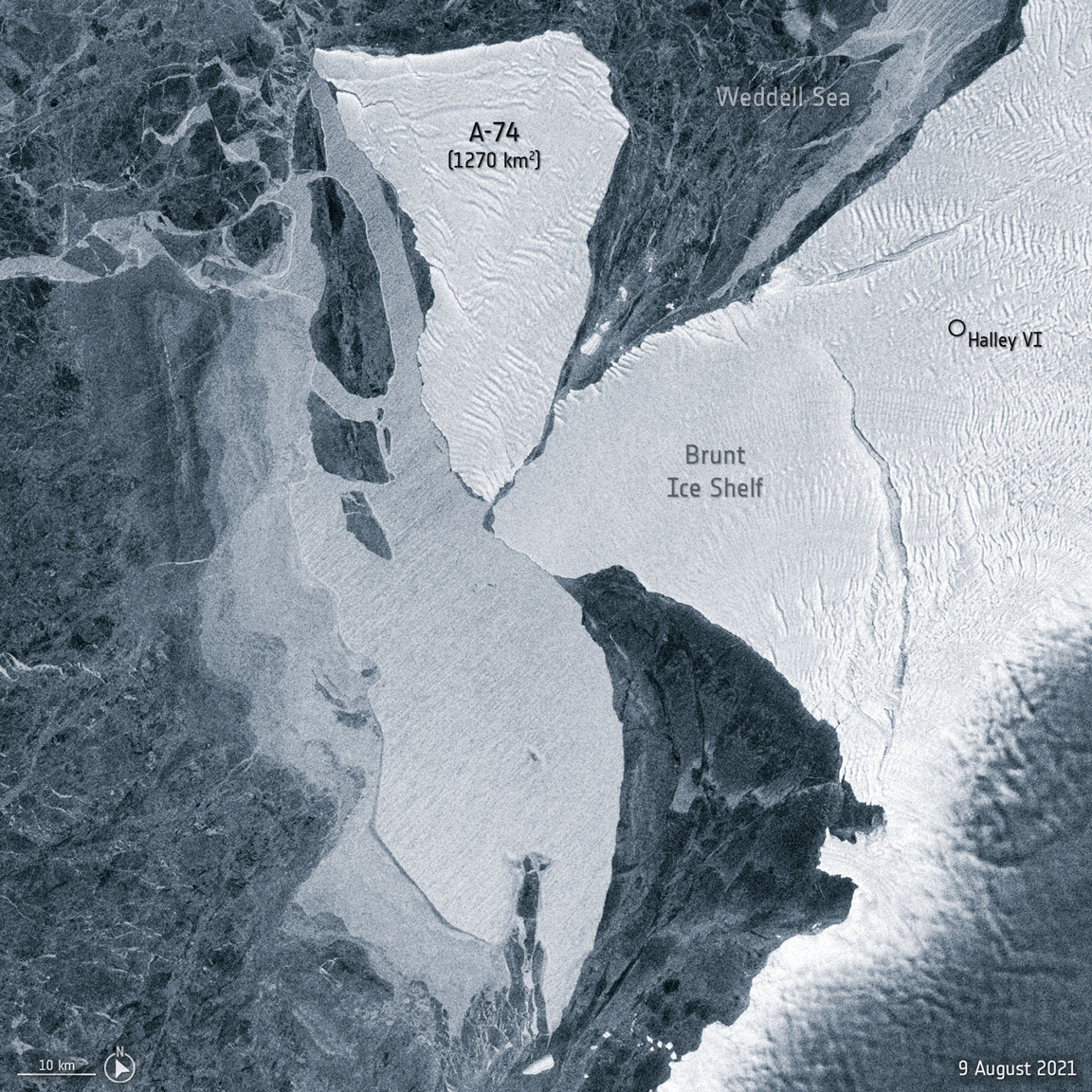Wild satellite view shows near-collision of giant A-74 iceberg in Antarctica

An iceberg 20 times the size of Manhattan careened dangerously close to its parent ice shelf in Antarctica, a series of satellite photos show.
The iceberg, called A-74, calved from Antarctica's Brunt Ice Shelf earlier this year and has been sticking close to the shelf for six months due to ocean currents, according to a statement from the European Space Agency (ESA). A strong east wind in early August then pushed A-74 into a near-collision that came close to spawning a still-more-massive iceberg.
ESA tracked the iceberg using radar aboard the Copernicus Sentinel-1 spacecraft. The new images showed the berg swinging near the ice shelf, which already is weakened by severe cracks and rifts, between Aug. 9 and 18.
Related: Watch this giant iceberg break off from Antarctica
"Had the drifting iceberg hit the unstable ice shelf with severe force, it may have triggered the release of a new 1,700 square kilometer [656 square mile]-sized iceberg," ESA officials wrote in the statement. For perspective, A-74 is roughly 490 square miles (1,270 square kilometers) in size.
Radar images are a requirement to monitor ice shelves in Antarctica, ESA added, because the region is plunged into 24-hour darkness during local winter and it can also be quite stormy or cloudy.
But the danger to the Brunt Ice Shelf continues. ESA said the glacial region threatened by A-74 is only "tenuously attached" to the seabed. Glaciologists continue to watch the formation and extension of rifts and chasms in the ice shelf, because already its unstable situation is causing problems for scientific researchers in the region.
Get the Space.com Newsletter
Breaking space news, the latest updates on rocket launches, skywatching events and more!
"With the ice shelf deemed unsafe due to the encroaching cracks in 2017, the British Antarctic Survey closed their Halley VI Research Station and re-positioned it to a more secure location," ESA said, noting the researchers moved 20 miles (32 km) inland. "Halley is made up of eight interlinked pods built on skis, which allows the pods to be easily moved in case of unstable ice or new chasms forming on the ice shelf," the agency added.
For the past half-decade, the researchers have only come to Halley in the Antarctic summer due to the difficulty of predicting accelerating iceberg calving, and the difficulty of leaving the region suddenly during the frigid winter. From Halley, more than a dozen GPS monitors measure and relay information about ice deformation of the shelf.
A-74 isn't the only major iceberg event in Antarctica in 2021. In February, another satellite photo north of Antarctica showed an "alphabet soup" of broken icebergs. The 11 pieces being tracked at that time used to belong to the world's largest iceberg, called A-68a.
The entire Antarctic region is under threat from global warming, as temperatures are up to 5 degrees Fahrenheit (3 degrees Celsius) higher in the region since the 1950s and continue to rise. That said, scientists don't think that human-induced climate change caused the calving of A-74 or another large iceberg that recently broke away from Antarctica, called A-76.
"A76 and A74 are both just part of natural cycles on ice shelves that hadn't calved anything big for decades," Laura Gerrish, a researcher at the British Antarctic Survey, wrote on Twitter. "It's important to monitor the frequency of all iceberg calving, but these are all expected for now."
Follow Elizabeth Howell on Twitter @howellspace. Follow us on Twitter @Spacedotcom and on Facebook.
Join our Space Forums to keep talking space on the latest missions, night sky and more! And if you have a news tip, correction or comment, let us know at: community@space.com.

Elizabeth Howell (she/her), Ph.D., was a staff writer in the spaceflight channel between 2022 and 2024 specializing in Canadian space news. She was contributing writer for Space.com for 10 years from 2012 to 2024. Elizabeth's reporting includes multiple exclusives with the White House, leading world coverage about a lost-and-found space tomato on the International Space Station, witnessing five human spaceflight launches on two continents, flying parabolic, working inside a spacesuit, and participating in a simulated Mars mission. Her latest book, "Why Am I Taller?" (ECW Press, 2022) is co-written with astronaut Dave Williams.









